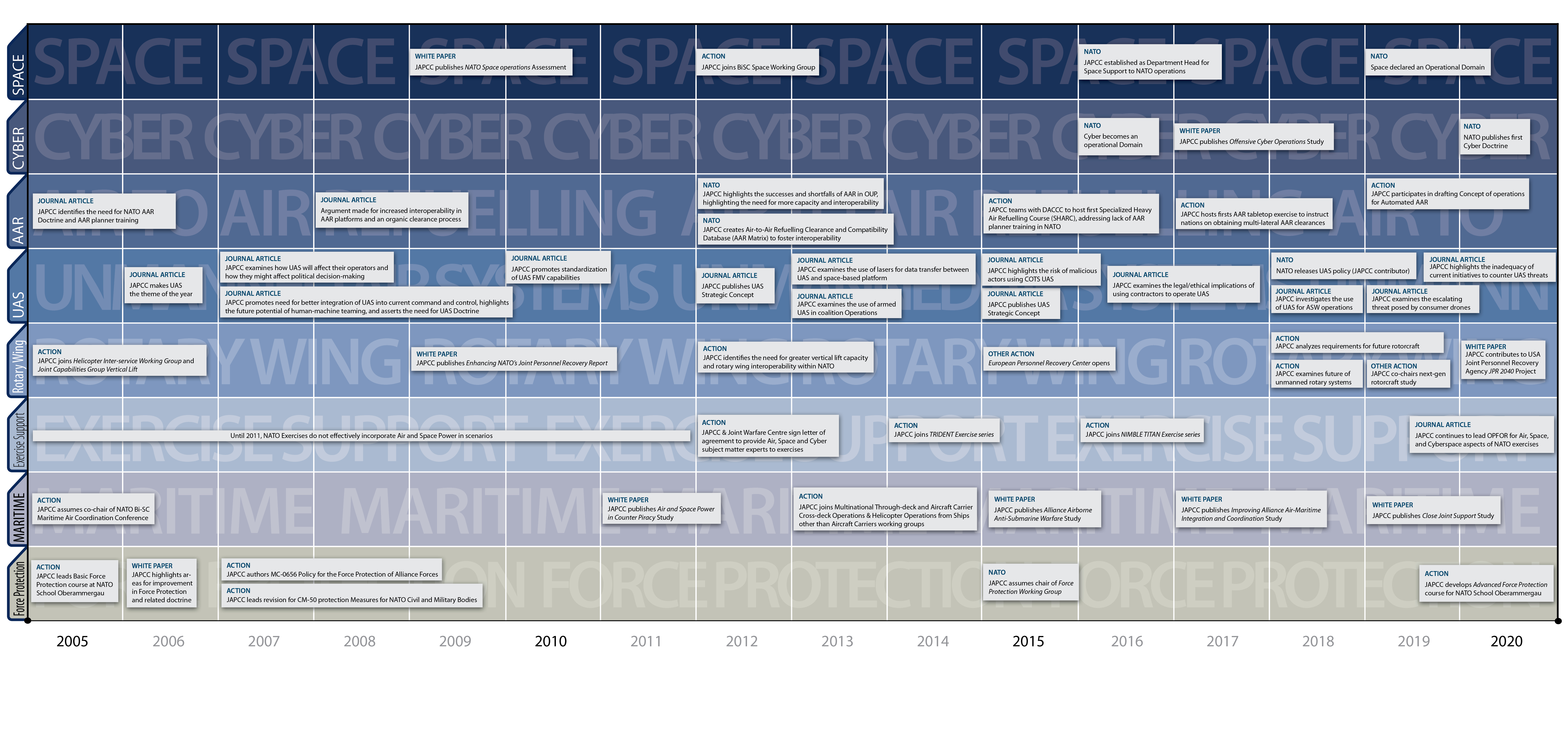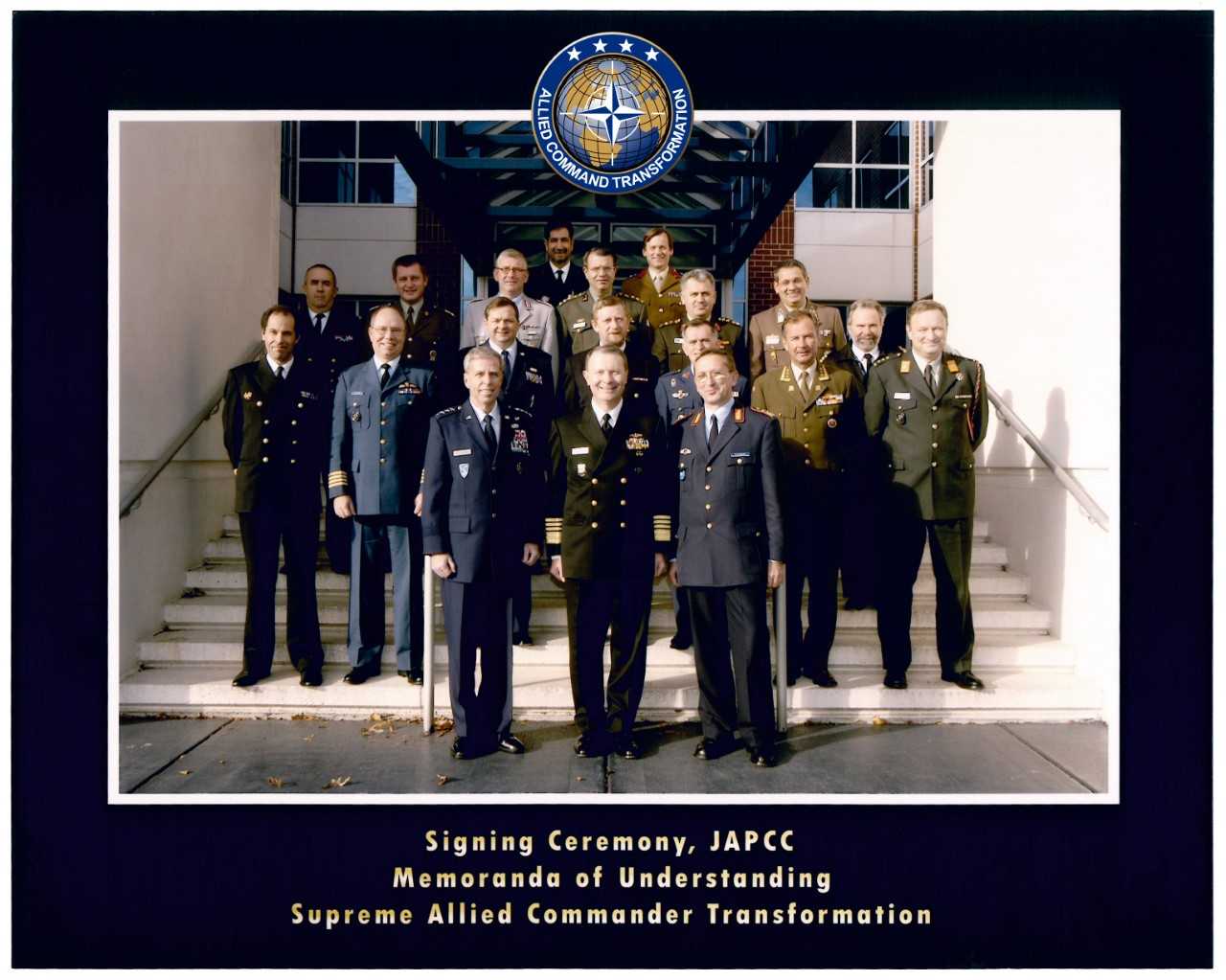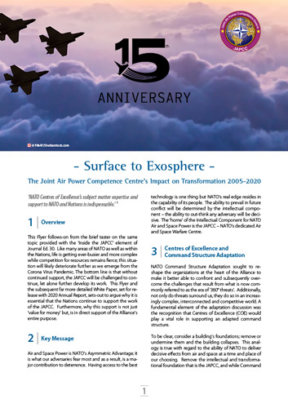‘NATO Centres of Excellence’s subject matter expertise and support to NATO and Nations is indispensable.’ 1
ACT JFD/CPD Brief in Lisbon 14 May 2019, Multinational Solutions Synchronization Conference.
Overview
This Flyer follows-on from the brief taster on the same topic provided with the ‘Inside the JAPCC’ element of Journal Ed. 30. Like many areas of NATO as well as within the Nations, life is getting ever-busier and more complex while competition for resources remains fierce; this situation will likely deteriorate further as we emerge from the Corona Virus Pandemic. The bottom line is that without continued support, the JAPCC will be challenged to continue, let alone further develop its work. This Flyer and the subsequent far more detailed White Paper, sets-out to argue why it is essential that the Nations continue to support the work of the JAPCC. Furthermore, why this support is not just ‘value for money’ but, is in direct support of the Alliance’s entire purpose.
Key Message
Air and Space Power is NATO’s Asymmetric Advantage; it is what our adversaries fear most and as a result, is a major contribution to deterrence. Having access to the best technology is one thing but NATO’s real edge resides in the capability of its people. The ability to prevail in future conflict will be determined by the intellectual component – the ability to out-think any adversary will be decisive. The ‘home’ of the Intellectual Component for NATO Air and Space Power is the JAPCC – NATO’s dedicated Air and Space Warfare Centre.
Centres of Excellence and Command Structure Adaptation
NATO Command Structure Adaptation sought to reshape the organizations at the heart of the Alliance to make it better able to confront and subsequently overcome the challenges that result from what is now commonly referred to as the era of ‘360° threats’. Additionally, not only do threats surround us, they do so in an increasingly complex, interconnected and competitive world. A fundamental element of the adaptation discussion was the recognition that Centres of Excellence (COE) would play a vital role in supporting an adapted command structure.
To be clear, consider a building’s foundations; remove or undermine them and the building collapses. This analogy is true with regard to the ability of NATO to deliver decisive effects from air and space at a time and place of our choosing. Remove the intellectual and transformational foundation that is the JAPCC, and while Command and Control would continue, its ability to stay ahead of our competitors would reduce over time. Alarmingly, it is offered, we would perhaps not appreciate this until too late. An apparent efficiency saving amounting to only a few hundred thousand Euros (the total running cost of the JAPCC) and a handful of very capable individuals to use elsewhere puts at risk the billions of Euros that we have expended on platforms and support structures and the thousands of people that we engage in the delivery of Air and Space Power. Unfortunately, the situation highlighted above is occurring by stealth. The reader is reminded that the increased personnel numbers required to establish an adapted NATO Command Structure were significantly reduced as a result of the acceptance of an underpinning assumption that the existing manpower and intellectual capacity of COEs would, going forward provide more direct support to the NATO Command Structure (NCS). To be blunt, this ‘acceptance’ seems to have been forgotten and COEs are gradually being denuded of personnel in order that the Nations can meet their commitments to fully staff the NCS. This ‘trickle’ is gradually but insidiously eroding the JAPCC’s foundations. Furthermore, Nations continue to offer more COEs. It would be unacceptable to state categorically that these are not required, however, why establish more when we are failing to properly staff the ones we already have? This is particularly true in subject matter and capability areas where existing COEs are already tasked to provide the necessary expertise, but not fully staffed to do so.

So What?
No Nation that considers itself a true Air and Space Power Nation would entertain divesting itself of its National Air (and/or Space) Warfare Centre capability, therefore, the Alliance cannot expect to function to its fullest potential without its integral Air and Space Warfare Centre – the JAPCC.
Internal Acceptance
The Leadership and staff of the JAPCC understand the daily realities that confront the Alliance as well as the Nations both individually, collectively within regions (i.e. the Baltics) and as a complete Alliance (including Partners). As a result, we recognize that difficult decisions are needed. However, given the view expressed above with regard to the JAPCC’s relevance and necessity, it is now our job to provide our supporters with the information they need to justify their continued support. To this end, we have set ourselves the task of compiling a comprehensive compendium of the JAPCC’s activities and considerable achievements spanning the organizations first 15 years of existence through the end of 2019. It should be noted that having recognized that this work is essential and that we need to justify continued and ideally enhanced support, this work has been undertaken as additional activity and producing it has not been undertaken at the expense of current or indeed, emerging tasks.
Methodology
In December 2019, the JAPCC underwent a Periodic Assessment (PA)², conducted by Allied Command Transformation (ACT); this assessment was the JAPCC’s second, the first having been conducted in 2013. Preparing for a PA takes a huge amount of work and crucially, needs the staff of a COE to properly consider the question: what have they and the organization really achieved? To answer this question required a ‘deep dive’ into all that the JAPCC had done over the past 7-years, for whom and to what effect? In delivering this work, successfully passing the PA and ultimately being re-accredited as a NATO COE, the JAPCC was forced to undertake a thorough review of itself.
Having twice now captured so much information about the JAPCC, the logical progression was to share this information with Sponsoring Nations and the JAPCC’s Customer Base. The challenge though, was how to combine two rather large documents (the PA Assessment Questionnaires compiled in 2013 and 2019 for ACT) into a more easily consumed and hence useful reference? The answer is that we are developing a new White Paper which currently has the working title ‘From Ground to Exosphere – The Joint Air Power Competence Centre 2005 to 2020. The White Paper will briefly describe what COEs are, describe the JAPCC itself and then major on two primary areas. Firstly, the JAPCC’s enduring outputs – those major activities that occur regularly and are the bedrock of the JAPCC’s Air and Space Power transformational activity. Second, the more dynamic and ever-changing activities or projects that feed the effective and resource-efficient delivery of Alliance Air and Space Power. These activities include, but are by no means limited to, direct support to operations, policy and concept development, exercise support, delivery of training, lessons learned etc. Indeed, anything that helps improve current, or likely future, delivery of effects from Air and Space.
Purpose
If anyone has ever wondered what the JAPCC is or what it does and why it should be supported, this publication will answer those questions. Not only will this White Paper be a historical record of the JAPCC’s 15-year history, but it will also explain why NATO needs a dedicated JointAir and Space Power Warfare Centre. Furthermore, we believe that it demonstrates that the JAPCC delivers value far above the resources invested; the JAPCC is both extremely effective and at the same time, incredibly resource-efficient. The question posed, therefore, should not be ‘why should nations possessing or aspiring to possess Air and Space capabilities invest or continue to invest but rather, why would any nation not want to invest?´ The JAPCC is in its 16th year of existence and while this may not seem such a long time, if it is thought of in terms of how the world we live in has changed and how these changes have affected the Domain of Air and Space, then one quickly starts to realise just how different things are now. Reading this White Paper will both reinforce this perspective and also demonstrate how the products of the JAPCC have been an integral part of a continuous process of evolution and sometimes revolution.
While many of those delivering the PA were JAPCC Subject Matter Experts (SMEs), their insight, at best, rarely went back beyond their immediate predecessor. Consider this: How many individuals in each of our nations have passed through the appointment of Chief of Defence Staff (CHoDS) or Air Chief since that group of Air Chiefs who signed the JAPCC’s Memorandum of Understanding (MoU) on 1 January 2005³, or indeed, how many different jobs have each of us done? The question thus becomes, that if we know so little about what has gone before in our own organization, then what chance does our wider audience have of understanding the JAPCC’s achievements? Therefore, having captured the JAPCCs achievements in two separate PAs, this new publication is the organizations attempt to provide an overview of the JAPCC’s entire body of work to date in a single, easily readable publication.
A Flavour of Things to Come
The JAPCC has evolved both through internal restructuring and based on the Direction and Guidance (D&G) provided by the Steering Committee (SC). It is offered that the JAPCC is now more relevant than ever and, in a complex and increasingly uncertain World, is more essential than ever. To provide an insight into what will be contained in the White Paper, this section provides a very brief snapshot of what the JAPCC is doing right now. The JAPCC operates based on the Director’s Vision and the accompanying, recently revised, Mission Statement:
Directors Vision: To be NATO’s catalyst for the improvement and transformation of Joint Air and Space Power, delivering effective solutions through independent thought and analysis.
Mission: The JAPCC, as a team of multinational experts, is to provide key decision-makers effective solutions on Joint Air and Space Power challenges, in order to safeguard NATO and the Nations’ interests. In conjunction with the overarching Mission Statement, the JAPCC operates on three, primary Guiding Principles:
- Contribute Joint Air and Space Power to Alliance decision-making processes through active leadership of and participation in NATO Committees, Working Groups and forums.
- Promote and showcase the effectiveness and relevance of Joint Air and Space Power as a critical element in Air, Land and Maritime operations.
- Partner with relevant NATO entities and nations to promote and synchronize output and products.
Current Projects, Activities and Tasks
Cascading from the above, the JAPCC currently has several hundred numbered objectives within its Programme of Work database. These objectives all have a clearly defined output for a nominated customer(s). In order to manage this workload across 5 Branches and 32 Subject Matter Areas, work is grouped under Focus Areas. While Focus Areas have changed with time, the JAPCC currently has 12 of these areas under which all objectives are grouped. Below are now listed, with a brief explanation of each, these current Focus Areas.
Joint All-Domain Operations and C2. The speed and lethality of modern systems demand technological solutions that enable operations at the speed of relevance and real-time battlespace management in all domains, especially the confined and congested land/maritime areas of operations that characterize much of NATO territory. Getting C2 ‘right’ across the domains is a critical first step towards the development of Joint All-Domain C2.
Space Support in Operations. The employment of Joint Air Power across the Air, Land and Maritime domains as become inextricably dependent on Space and Spacebased capabilities. With the recent recognition by NATO of Space as an operational domain, JAPCC will support the Initial Implementation Plan and continue to contribute to the coordination of Education and Training, support Exercises, and recommend ways to ensure Operational Space Support to NATO, improve Space Domain Coordination and develop Space Domain Awareness.
Cyberspace Integration. Cyberspace is not only a domain through which Joint Air and Space operational and C2 forces operate, it has become an operational domain of its own. JAPCC promotes and influences the development of Cyberspace doctrine, policy, operational concepts and capabilities with a focus on the integration with NATO Joint Air and Space Power. The Centre also supports the evolution and development of cyberspace as an Operational Domain particularly as it relates to and integrates with NATO Joint Air and Space Power.
Rotary Wing/Vertical Lift Transformation. The future physical operating environment and rapidly advancing urbanization point to an increasing need for capable and survivable Rotary Wing and Vertical Lift. Standardization of equipment, training, tactics and procedures is critical.
Integrated Air and Missile Defence. NATO Integrated Air and Missile Defence (NATO IAMD) is an essential, continuous mission in peacetime, crisis and conflict. JAPCC is supporting IAMD policy and doctrine development, especially the Surface-Based Air and Missile Defence facet. JAPCC is involved in IAMD exercises, experiments and studies to advance this cornerstone of NATO’s deterrence.
Logistics Support to Air Operations. Air-to-Air Refuelling, Air Transport, and Aircraft Cross-Servicing are all critical enablers for not only collective defence and enhanced deterrence, but also for conducting and sustaining out of area operations. Airfield and Space ground station logistics at sovereign as well as deployed sites are also important yet vulnerable to new methods of interdiction via the Space and Cyberspace domains. Improving interoperability between nations and standardizing operating procedures and security protocols is necessary to ensure Logistics continues to be an enabler and force multiplier.
Force Protection. Threats against both command and force structures continuously evolve in all domains, and so must our tactics, techniques and procedures to defend against them. Continuous work is needed to analyse threats, create new, and update existing practices, and to identify and leverage technologies that can be employed to counter a broad spectrum of threats against airfields, Space ground infrastructure, supply lines and out of area locations.
Electromagnetic Spectrum Operations. JAPCC is assisting with the development of NATO policy and doctrine in the area of Electromagnetic Operations (EMO) to ensure the synchronization in the areas of Suppression of Enemy Air Defences (SEAD), Electronic Warfare (EW), Cyberspace Operations and Intelligence, Surveillance, Target Acquisition and Reconnaissance (ISTAR).
Joint ISR and Big Data Management. The development of concepts within NATO related to Joint Intelligence Surveillance and Reconnaissance (JISR) by publication of thoughts and opinions is supported. This is accomplished through researching to support concept development, standardization and doctrine, education and training. Moreover, JAPCC promotes the evolution of NATO ISR policy by studying new methods of data fusion and analysis based on new technologies.
Unmanned Air Systems/Countering Unmanned Air Systems. Unmanned Air Systems (UAS) present opportunities to improve capabilities across the range of military operations, with potential legal and ethical challenges. JAPCC supports the development of NATO policy and doctrine addressing the full range of UAS, including Unmanned Combat Aerial Vehicles. We address not only Alliance use of these systems but also the challenges when having to counter them.
Emerging Technologies. New technologies may advance existing capabilities in an evolutionarily way or enable disruptive developments. In particular, game-changing technologies and the challenges they pose have to be understood and taken into account when we build and prepare our forces and their Command & Control. JAPCC is poised to enquire how artificial intelligence, and other technological advancements may challenge the traditional way of posturing and employing our air and space capabilities.
Resilient Basing. NATO faces a 360-degree threat environment spanning the range of intensity from Violent Extremist Organizations to Peer Competitors. Modern technology is constantly introducing new threat vectors through evolving traditional kinetic military capabilities as well as via the Space and Cyberspace Domains. Greater and more insidious threats to our main operating bases and force structure dictate a need to develop, and in some cases re-learn, how the Alliance can distribute and disperse both force and C2 structure for survivability and resiliency.
Summary
Hopefully this Flyer has gone some way to ‘whet the appetite’ with regard to the White Paper to come? What is written here has been a very brief summary of what is happening now. However, to properly understand why the JAPCC, the Alliances’ Air and Space Warfare Centre, is essential to continued success, one needs to understand the entirety of what the JAPCC has done and how much of what is taken for granted in terms of contemporary NATO Air and Space Power thinking, has emerged from JAPCC work.
Look Ahead
As you read this, the White Paper is well on its way to completion. The White Paper is designed to be an enduring record of achievement but with the specific purpose of reinforcing current support and encouraging further commitment. This White Paper is our attempt to record what your investment has delivered. Looking forward we envisage further dialogue on where perhaps the JAPCC should be steering in the timeframe 2021 to 2035?









